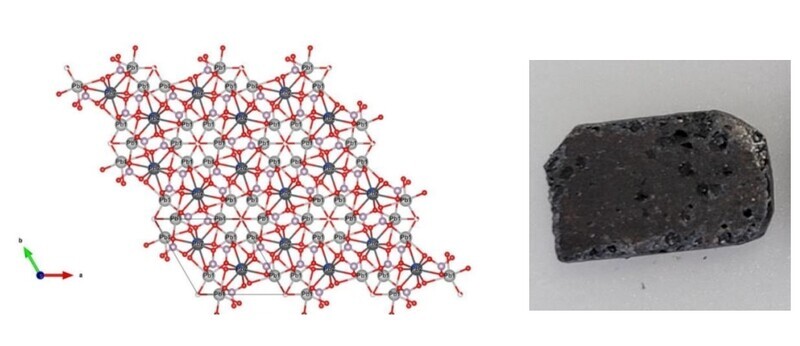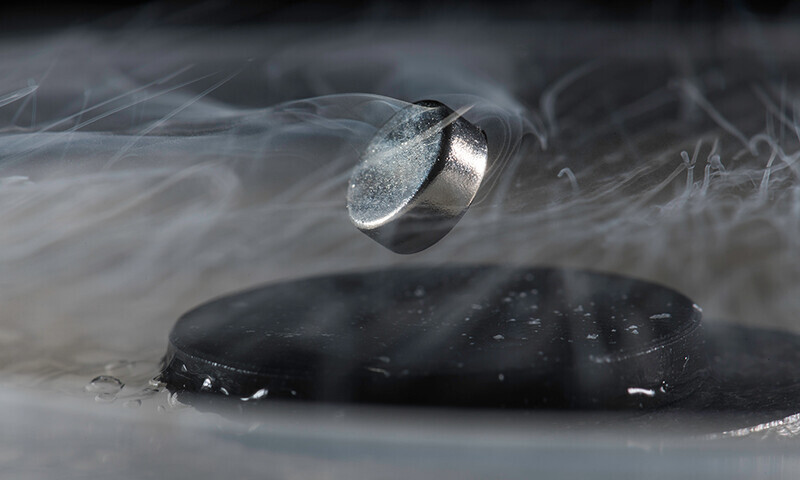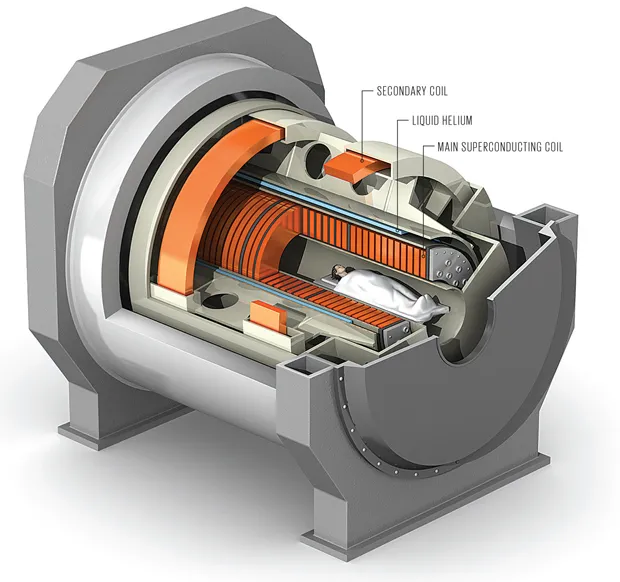
Still from a video published by Korean researchers at Quantum Energy Research Centre supposedly showing LK-99, a newly synthesized superconductor, levitating on a magnet.
The international science community is abuzz following the recent publication of two research papers authored by Korean scientists claiming they synthesized a superconductor that operates in normal temperature and pressure.
As the word spread that the “holy grail” of physics may have been developed, the word “superconductor” emerged as a new buzzword in online communications. Wired, a magazine that specializes in technological coverage, reported that condensed matter physics replaced large language models like ChatGPT as one of the most popular topics of discussion on social media platforms like Twitter (now X) and in online communities like Reddit, enlivening online betting sites as well.
When the controversy surrounding the matter got heated, with researchers posting their personal interpretations, assessments and speculations on social media en masse, while shares of associated companies fluctuated on the stock market, a Korean scholarly association set out to verify the research papers’ claims a mere 10 days after they were made public.
Superconductivity is a phenomenon whereby a substance displays zero electric resistance. Electric resistance declines as the temperature decreases, vanishing once a certain temperature is reached. With zero electric resistance, electricity can be conducted with no energy loss whatsoever, which can revolutionize energy use.
Superconductors are also diamagnetic, repelling magnetic fields. This property allows superconductors to levitate magnetic substances, which can be applied in various fields to make magnetic levitation trains or hyperloops, precision measuring instruments and nuclear fusion reactors.
However, with today’s technology, superconductivity can only be reproduced in extremely low temperatures (below 100 degrees Celsius) and under immense pressure (over 100,000 times that of atmospheric pressure). As such, the utilization of superconductors remains extremely limited, only used in technology equipped with cryogenic capabilities such as magnetic resonance imaging and quantum computers. Although many scientists around the world attempted to develop a room-temperature superconductor, the feat remained a challenge until now.
What the team of Korean researchers are claiming
On July 22, a team of Korean scientists posted two research papers about a superconductor displaying superconductivity at room temperature on Arxiv (pronounced “archive”), an online archive for papers in the pre-publication stage. Scholars can share research papers that have not yet gone through the peer-review process and thus have yet to be verified by academia on this website.
Authors listed primarily included members of the Quantum Energy Research Centre’s research team, such as Lee Suk-bae, the institute’s president, as well as Hanyang University professor emeritus Auh Keun-ho and Kim Hyun-tak, who previously worked for the government-funded Electronics and Telecommunications Research Institute.

LK-99’s structure, and what the synthesized material looks like. (from Arxiv)
The researchers shared that they observed superconductivity in LK-99, a modified lead-apatite structure that is dark gray in color, at the critical temperature of 127 degrees Celsius (400 K), meaning they reproduced superconductivity at room temperature. This substance, synthesized by heating up lanarkite (a mixture of lead oxide and lead sulfate) and copper phosphide at the high temperature of 925 degrees Celsius for 5 to 20 hours, displayed the two key properties of superconductors — zero electric resistance and magnetic levitation.
The researchers explained that one of the 10 lead atoms making up the lead-based apatite structure was substituted by a copper atom, reducing the structure’s volume by 0.48% and inducing superconductivity.
The lanarkite used in the experiment was obtained by mixing lead oxide and lead sulfate at a 1:1 ratio and heating up the mixture at 725 degrees Celsius for 24 hours, while the copper phosphide was obtained by mixing copper and phosphorus powder and heating up the mixture at 550 degrees Celsius for 48 hours.
In their acknowledgement, the scientists dubbed their discovery the product of 20 years of research based on a hypothesis put forth by Chair Tong-seek (1943-2017), who served as professor emeritus of chemistry at Korea University in the 1990s. The team has reportedly submitted their research paper to APL Materials, an international open access journal. Quantum Energy is a company founded in 2008 by researchers who formerly worked with Chair.
Uneven levitation: The result of an imperfect sample?
Michael Norman, a distinguished fellow at Argonne National Laboratory in the US, pointed out three problems with the ingredients the Korean researchers used in their experiment in Science, an international academic journal. According to Norman, because apatite on its own is a nonconducting mineral, it is not a suitable ingredient to synthesize a superconductor. Plus, as the atoms of lead and copper have similar electronic structures, substituting copper atoms for some of the lead atoms would not significantly affect the electrical properties of the material. Norman also argued that the weight of lead atoms would get in the way of inducing superconductivity.

A magnet levitates above a superconductor cooled with liquid nitrogen, demonstrating the Meissner effect. (courtesy of the University of Rochester)
In her article published in The Conversation, Mahboobeh Shahbazi, a senior research fellow in material science at Queensland University of Technology, commented that the Korean researchers “propose a plausible theory of how LK-99 might display room-temperature superconductivity, but have not provided definite experimental evidence.” She added, “The data presented in the papers appear inconclusive.”
The video the Korean researchers made public of their superconductor did not perfectly display magnetic levitation, also known as the Meissner effect. The researchers attempted to demonstrate superconductivity by placing a piece of LK-99 on top of a magnet, but only one end of the LK-99 levitated, while the opposite end remained on the magnet.
During an interview with New Scientist, Kim, a research professor at William & Mary College who participated in the experiment, explained that this was “due to the sample being imperfect.” Kim told the magazine that while “both papers present similar measurements, [. . .] the second paper contains many ‘defects’ and was uploaded to arXiv without his permission.”
Shahbazi wrote that while “the behavior we see in the video may be due to imperfections in the sample,” it is “too early to say we have been presented with compelling evidence for room-temperature superconductivity.”
Reproduction and reliability will prove key
Determining whether a room-temperature superconductor has really been synthesized depends on whether following the synthesis method presented by the Korean researchers results in a substance that displays properties of superconductivity.
Scientists abroad have already started to share their review or examination of the method on Arxiv.

Stills from a video published by researchers in China who attempted to recreate LK-99. The researchers said that the fragment of LK-99 levitated and fell depending on the placement of the magnet. (from @Acdercot on Twitter)
On Tuesday, Sinead Griffin, a researcher at Lawrence Berkeley National Laboratory in the US, posted a research paper detailing the simulation of LK-99’s structure using a supercomputer, concluding that superconductivity may occur in temperatures higher than that observed in existing superconductors. However, researchers at Beihang University in China shared that their synthesis of LK-99 failed to achieve magnetic levitation. Scientists in India also joined in, stating that they could not replicate the Korean researchers’ experiment.
Researchers from China’s Huazhong University of Science and Technology have released a video demonstrating their recreation of the crystal structure of LK-99 and confirming its diamagnetic properties. However, the video fails to show magnetic levitation.
“The material in the video shared by the Chinese researchers is likely ferromagnetic [rather than diamagnetic],” wrote Yoon Bokwon, a Georgia Institute of Technology researcher in physics with experience in superconductors, on Facebook.
In his interview with New Scientist, Kim stated that once the findings are published in a peer-reviewed journal, he will support anyone who wants to create and test LK-99 for themselves.
According to Wired, since LK-99 is relatively simple to make, it is estimated that dozens of teams of experts and amateurs are working on reproducing the material, publicly and privately.
Scholarly society says declarations of ambient superconductor are premature
South Korean scientists are also getting in on the action. The Korean Society for Superconductivity and Cryogenics has decided to form a “room-temperature superconductivity verification committee” chaired by Seoul National University professor Kim Chang-young.

Andrew McCalip, an engineer at Varda Space Industries, is one of the people publicly attempting to recreate LK-99. (courtesy of McCalip/Wired)
The society said on Wednesday that it formed the committee because while it wanted to observe the verification results from domestic and international research institutions through normal channels, “the considerable controversy over the authenticity of the results in the past few days and the emergence of other unverified claims from fellow researchers has prompted this committee’s formation.”
For now, the society isn’t sold on the idea that the holy grail has been found.
“Based on data from the two Arxiv papers and the video made public, the materials cannot be called room temperature superconductors at this point,” the society said in a statement.
Once Quantum Energy provides the society with samples, it plans to share them with Seoul National University, Sungkyunkwan University, and Pohang University of Science and Technology to verify and make measurements.
According to the society, the Sungkyunkwan University’s Center for Quantum Materials and Superconductivity, Korea University’s Laboratory of Superconducting Materials and Applications, and Seoul National University’s Center for Novel States of Complex Materials Research are also conducting research to reproduce LK-99.

A sample of a room-temperature superconductor synthesized by researchers at the University of Rochester and published in Nature this March. (courtesy of the University of Rochester)
“Blue ocean” of superconductivity research, with 10 Nobel Prize in Physics winners
Superconductors are considered a proverbial blue ocean research field in the global scientific community, with more than 10 scientists receiving the Nobel Prize in Physics in five instances.
The history of the discovery and development of superconductors is more than 110 years old. In 1911, Dutch physicist Heike Kamerlingh Onnes discovered that mercury cooled to minus 269 degrees Celsius in liquid helium suddenly lost its electrical resistance. He was awarded the Nobel Prize in Physics in 1913 for his work.
Scientists then rushed to find substances that exhibit superconductivity at higher temperatures.
In 1957, American scientists succeeded in theoretically explaining the phenomenon of superconductivity (BCS theory), and in 1986, Swiss scientists discovered the first high-temperature superconductor with a critical temperature of minus 238 degrees Celsius (35 K).
Materials that exhibit superconductivity at temperatures above 30 degrees Celsius (minus 243 degrees Fahrenheit) are classified as high-temperature superconductors.
These two achievements led to the Nobel Prize in Physics in 1972 and 1987, respectively. So far, the highest temperature at which superconductivity has been achieved is minus 23 degrees Celsius.

Magnetic resonance imaging, or MRI, uses a coil of superconductive material. (courtesy of Emily Cooper/IEEE Spectrum)
However, behind every glory, there is a dark side.
In 2020, Ranga Dias, a professor at the University of Rochester, and his team announced in the international journal Nature that they had developed a room-temperature superconductor that operated at 15 degrees Celsius and 1 million atmospheres of pressure.
After fellow researchers pointed out that the superconductor was impossible to reproduce, Nature retracted the paper in 2022.
In March 2023, Dias again announced in Nature that he had created a new superconductor — a compound of lutetium, hydrogen, and nitrogen — that works at 21 degrees Celsius, but scientists who remember the previous debacle remained skeptical.
All eyes are now on the upcoming peer-reviewed results to see if the Korean researchers’ recently published paper will continue its march to Nobel glory, or join the ranks of countless others that have stalled at the threshold of academic validation.
By Kwak No-pil, senior staff writer
Please direct questions or comments to [
english@hani.co.kr]









![[Column] A year and a half of Yoon’s foreign, security policies has added to Korea risk [Column] A year and a half of Yoon’s foreign, security policies has added to Korea risk](https://flexible.img.hani.co.kr/flexible/normal/500/300/imgdb/original/2023/1226/1517035766989839.jpg) [Column] A year and a half of Yoon’s foreign, security policies has added to Korea risk
[Column] A year and a half of Yoon’s foreign, security policies has added to Korea risk![[Column] Korea’s diaspora discrimination [Column] Korea’s diaspora discrimination](https://flexible.img.hani.co.kr/flexible/normal/500/300/imgdb/original/2023/1225/3417034701814775.jpg) [Column] Korea’s diaspora discrimination
[Column] Korea’s diaspora discrimination